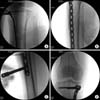Abstract
Minimally invasive plate osteosynthesis (MIPO) is beneficial for proximal tibial fractures since these injuries are mostly caused by high energy traumas. The advantages of MIPO are minimization of soft tissue dissection and preservation of periosteal vascularization. Lateral plating has mostly developed as MIPO for proximal tibial fractures. We introduce minimal invasive percutaneous plate stabilization using a medial locking plate as alternative treatment for proximal tibial fractures.
Figures and Tables
 | Fig. 1Operative procedure.
(A) Drawing of main structures on the skin (arrow: medial collateral ligament, arrow head: the tibial insertion site of hamstring tendon).
(B) Dissecting between the insertion site of the hamstring tendon and that of the medial collateral ligament by Cobb's elevator.
(C) Insertion of a plate through the space between the insertion site of the hamstring tendon and that of the medial collateral ligament.
(D) Suturing.
|
References
1. Byun YS, Park KC, Bong HJ, Lee CH. Minimally invasive plate osteosynthesis for proximal tibial shaft fracture. J Korean Fract Soc. 2011; 24:23–27.

3. Dendrinos GK, Kontos S, Katsenis D, Dalas A. Treatment of high-energy tibial plateau fractures by the Ilizarov circular fixator. J Bone Joint Surg Br. 1996; 78:710–717.

4. Ha SH, Kim DH, Lee JY. Treatment of Proximal Tibia Fractures Using LCP by MIPO Technique. J Korean Fract Soc. 2010; 23:34–41.

5. Lang GJ, Cohen BE, Bosse MJ, Kellam JF. Proximal third tibial shaft fractures. Should they be nailed? Clin Orthop Relat Res. 1995; (315):64–74.
6. Mullaji AB, Padmanabhan V, Jindal G. Total knee arthroplasty for profound varus deformity: technique and radiological results in 173 knees with varus of more than 20 degrees. J Arthroplasty. 2005; 20:550–561.
7. Oh CW, Oh JK, Jeon IH, et al. Minimally invasive percutaneous plate stabilization of proximal tibial fractures. J Korean Fract Soc. 2004; 17:224–229.





 PDF
PDF ePub
ePub Citation
Citation Print
Print



 XML Download
XML Download